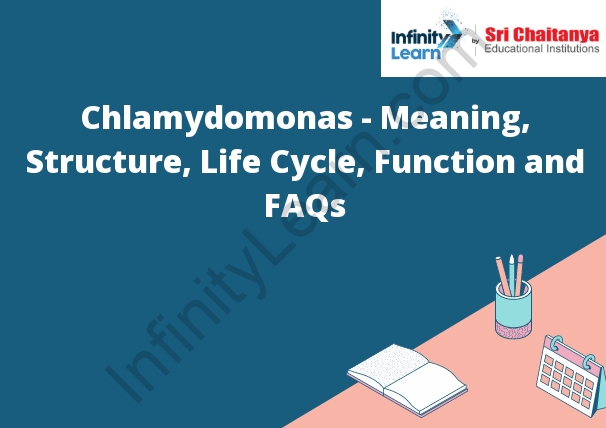Table of Contents
Chlamydomonas
Chlamydomonas – Meaning: Chlamydomonas reinhardtii is a unicellular green alga that is widely used as a model organism in the fields of genetics, cell biology, and biochemistry.Chlamydomonas is a haploid organism that reproduces asexually by mitosis. It has a simple cell structure with a single nucleus and a single chloroplast. Chlamydomonas is a photosynthetic organism that uses light energy to convert carbon dioxide and water into glucose and oxygen. It is a fast-growing organism that can divide every 20 minutes.

Structure of Chlamydomonas
Chlamydomonas is a unicellular green alga that is about 10 micrometers in diameter. It has a single, large chloroplast that is about 1/3 the diameter of the cell. The chloroplast has a pyrenoid, which is used for starch storage, and two large, oval, photosynthetic thylakoids. The cells are surrounded by a cell wall and a plasma membrane. The plasma membrane has a small number of embedded proteins, including a number of light-harvesting complexes. The cells are motile and have two flagella, which are used for swimming.
The Life Cycle of Chlamydomonas
Chlamydomonas is a type of single-celled green algae that reproduces asexually by dividing in two. It grows best in warm, moist environments and typically lives for a week or two.
Chlamydomonas Classification
Chlamydomonas is a single-celled alga that is found in both fresh and salt water. It is a photosynthetic organism that contains chloroplasts and is capable of producing its own food. Chlamydomonas can also reproduce asexually by dividing in two, and sexually by fusion of two cells.
Chlamydomonas Characteristics
Chlamydomonas is a unicellular alga that is green in color and has a single, prominent chloroplast. It has a cell wall that is composed of cellulose and a small amount of peptidoglycan. Chlamydomonas is a motile organism and has two flagella that it uses for propulsion. It is a photosynthetic organism and can produce its own food through photosynthesis. Chlamydomonas reproduces asexually by binary fission.
Chlamydomonas Function
- Chlamydomonas is a unicellular green alga that lives in freshwater habitats. It has a single, simple cell with a nucleus, chloroplasts, and a cell wall. Chlamydomonas uses photosynthesis to produce energy from light, and it can also store energy in the form of starch. Chlamydomonas reproduces asexually by dividing in two, and it can also reproduce sexually by forming spores.
- Chlamydomonas is a unicellular green alga that has a number of important functions in the environment. It is a photosynthetic organism that produces oxygen and helps to cycle nutrients. It also helps to stabilize the soil and can be used to bioremediate polluted areas.
- One of the most important functions of Chlamydomonas is its role in photosynthesis. This alga uses light energy to produce organic matter from carbon dioxide and water. This process helps to produce oxygen gas, which is necessary for life on Earth. Chlamydomonas also helps to cycle nutrients, which is important for the health of the environment. It can extract nitrogen, phosphorus, and other nutrients from the soil and water and recycle them back into the environment.
- Chlamydomonas can also be used to bioremediate polluted areas. It can extract pollutants from the soil and water and break them down into harmless components. This can help to clean up polluted areas and restore the environment.









